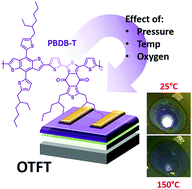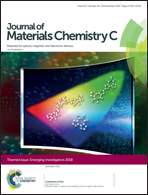The influence of air and temperature on the performance of PBDB-T and P3HT in organic thin film transistors†
Abstract
Conjugated polymers such as poly(3-hexylthiophene) (P3HT) are commonly used as semiconducting components in organic photovoltaics (OPVs) and organic thin-film transistors (OTFTs). Such devices may be exposed to oxygen or moisture in air and increased temperature during operation, potentially affecting their charge transport properties. Therefore, we produced the first reported examples of OTFTs using PBDB-T, a conjugated push–pull polymer used in high performance OPVs, and assessed their performance compared to P3HT under different environmental conditions. Drop casted and annealed bottom-gate, bottom-contact (BGBC) devices had an average mobility of 0.06 cm2 V−1 s−1, an on/off current ratio of 104 and a desirable threshold voltage around 0 V. These OTFTs showed distinct responses to characterization at increased temperature in vacuum (P < 0.1 Pa) and air, with PBDB-T devices retaining their performance better than P3HT over time. These findings suggest PBDB-T has higher stability to oxidation when exposed to air than P3HT, especially at high temperatures, and therefore represent a more stable alternative for use in OTFTs and OPVs.

- This article is part of the themed collection: Journal of Materials Chemistry C Emerging Investigators


 Please wait while we load your content...
Please wait while we load your content...